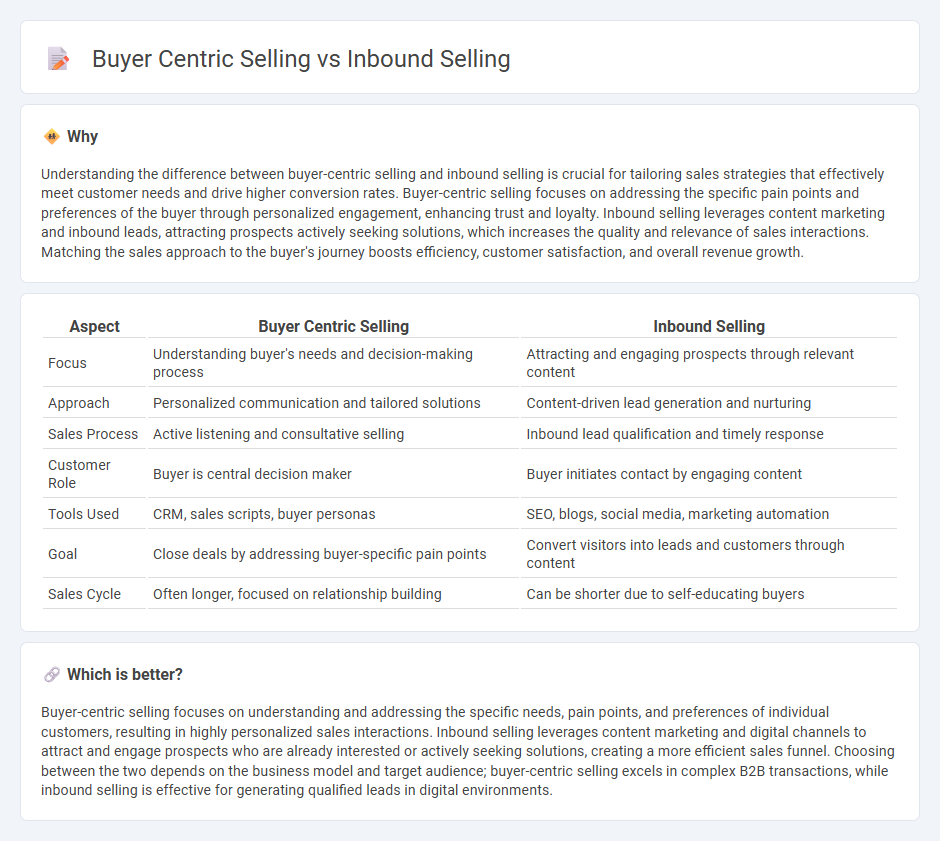
Buyer-centric selling focuses on understanding and addressing the specific needs, preferences, and pain points of the customer throughout the sales process, creating a personalized experience that fosters trust and long-term relationships. Inbound selling emphasizes attracting potential customers through valuable content and engagement, guiding them naturally towards making a purchase decision by aligning with their buying journey. Discover how combining these strategies can optimize your sales performance and boost customer satisfaction.
Why it is important
Understanding the difference between buyer-centric selling and inbound selling is crucial for tailoring sales strategies that effectively meet customer needs and drive higher conversion rates. Buyer-centric selling focuses on addressing the specific pain points and preferences of the buyer through personalized engagement, enhancing trust and loyalty. Inbound selling leverages content marketing and inbound leads, attracting prospects actively seeking solutions, which increases the quality and relevance of sales interactions. Matching the sales approach to the buyer's journey boosts efficiency, customer satisfaction, and overall revenue growth.
Comparison Table
| Aspect | Buyer Centric Selling | Inbound Selling |
|---|---|---|
| Focus | Understanding buyer's needs and decision-making process | Attracting and engaging prospects through relevant content |
| Approach | Personalized communication and tailored solutions | Content-driven lead generation and nurturing |
| Sales Process | Active listening and consultative selling | Inbound lead qualification and timely response |
| Customer Role | Buyer is central decision maker | Buyer initiates contact by engaging content |
| Tools Used | CRM, sales scripts, buyer personas | SEO, blogs, social media, marketing automation |
| Goal | Close deals by addressing buyer-specific pain points | Convert visitors into leads and customers through content |
| Sales Cycle | Often longer, focused on relationship building | Can be shorter due to self-educating buyers |
Which is better?
Buyer-centric selling focuses on understanding and addressing the specific needs, pain points, and preferences of individual customers, resulting in highly personalized sales interactions. Inbound selling leverages content marketing and digital channels to attract and engage prospects who are already interested or actively seeking solutions, creating a more efficient sales funnel. Choosing between the two depends on the business model and target audience; buyer-centric selling excels in complex B2B transactions, while inbound selling is effective for generating qualified leads in digital environments.
Connection
Buyer centric selling and inbound selling both focus on aligning sales strategies with the needs and behaviors of potential customers, enhancing engagement through personalized interactions. Inbound selling leverages content marketing and digital tools to attract and educate buyers, supporting the buyer-centric approach of addressing specific pain points and preferences. By integrating these methods, businesses create a seamless buyer journey that drives higher conversion rates and customer satisfaction.
Key Terms
**Inbound Selling:**
Inbound selling prioritizes attracting and engaging potential customers through valuable content and personalized interactions, aligning with the buyer's journey and needs. This approach leverages digital channels, SEO strategies, and targeted outreach to convert leads organically, fostering trust and long-term relationships. Discover how inbound selling can transform your sales strategy by driving qualified leads and boosting conversions effectively.
Lead Nurturing
Inbound selling emphasizes attracting and engaging potential customers by providing valuable content and tailored interactions throughout the buyer's journey, enhancing lead nurturing effectiveness. Buyer-centric selling focuses on understanding the buyer's specific needs and challenges, personalizing communication to build trust and guide prospects naturally toward a purchase decision. Explore detailed strategies to optimize lead nurturing through both inbound and buyer-centric sales approaches.
Content Personalization
Inbound selling emphasizes attracting potential customers through tailored content that aligns with their interests and pain points, enhancing engagement and trust. Buyer-centric selling prioritizes understanding the buyer's journey and personalizing interactions and content to meet specific needs at each stage. Discover how mastering content personalization can transform your sales approach and drive higher conversion rates.
Source and External Links
What is Inbound Sales? Methodology, Strategies & More - Salesloft - Inbound selling is a modern sales framework that creates personalized buying experiences through a four-step process: identify, connect, explore, and advise to engage active and passive buyers effectively.
Inbound Selling: How to Meet Buyers Where They Are - Docket AI - Inbound selling is a customer-focused sales approach that meets buyers where they are by attracting, engaging, and guiding them with relevant information, emphasizing trust and value over aggressive selling.
Inbound Sales: Definition, Processes, Best Practices - Yesware - Inbound selling leverages the buyer's self-directed research by providing valuable insights and content that qualify leads early, making the sales process more efficient and effective compared to outbound methods.
 dowidth.com
dowidth.com